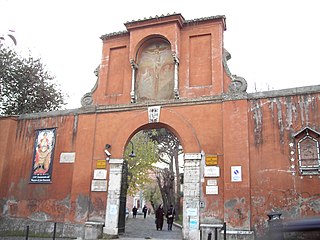
Giovanni Battista (Carlo) de Rossi was an Italian archaeologist, famous even outside his field for rediscovering early Christian catacombs.
Antonio Bosio was a Maltese scholar, the first systematic explorer of subterranean Rome, author of Roma Sotterranea and first urban spelunker.

Nereus and Achilleus are two Roman martyr saints. In the present General Roman Calendar, revised in 1969, Nereus and Achilleus (together) are celebrated on 12 May.

The Porta Nomentana was one of the gates in the Aurelian Walls of Rome, Italy. It is located along viale del Policlinico, around 70 m east of Porta Pia. It is now blocked and merely a boundary wall for the British Embassy.
The Catacomb of Balbina or Catacomb of Mark is a catacomb between the ancient via Appia antica and via Ardeatina in the Ardeatino district of Rome.
The Pontifical Academy of Archaeology is an academic honorary society established in Rome by the Catholic Church for the advancement of Christian archaeological study. It is one of the ten such Pontifical Academies established by the Holy See.

The Catacomb of Saint Agnes is one of the catacombs of Rome, placed at the second mile of via Nomentana, inside the monumental complex of Sant'Agnese fuori le mura, in the Quartiere Trieste.
The Catacombs of San Valentino is one of the catacombs of Rome (Italy), placed at the 2nd mile of the via Flaminia, now in Viale Maresciallo Pilsudski, in the modern Pinciano neighborhood.

The Catacomb of San Pancrazio is a catacomb of Rome (Italy), located in the Via Aurelia, within the modern Quartiere Gianicolense.

Salario is the 4th quarter of Rome (Italy), identified with the initials Q. IV.

Nomentano is the 5th quartiere of Rome (Italy), identified by the initials Q. V. The name derives from the ancient road Via Nomentana. It belongs to the Municipio II.
The Catacomb of Sant' Ermete or Catacomb of Bassilla is a catacomb on the former via Salaria in Rome, now sited in the Pinciano district on via Berolini. It originated some time between 200 and 250.

The Catacomb of Santi Marco e Marcelliano is a catacomb between the ancient via Appia antica and via Ardeatina in what is now the Ardeatino district of Rome. With the catacomb of Callixtus and the Catacomb of Balbina, it is one of three catacombs in the Callixtian Complex between the via Appia antica, via Ardeatina and vicolo delle Sette Chiese.
The Catacomb of Saint Castulus is one of the catacombs of Rome, the first cemetery beyond Porta Maggiore along the ancient via Labicana. It is sited on via San Castulo near the old via Casilina, in the Tuscolano quarter. It is now in a poor condition and inaccessible.

The Catacomb of Sant'Ippolito is a catacomb on the via Tiburtina in Rome, now entered from via dei Canneti in the modern Nomentano quartiere.
The Catacombs of Santa Felicita or Catacomb of Maximus is a three-level complex of catacombs on the modern via Salaria in the modern Salario quarter of Rome. In the 17th century it was also known as the Catacomb of Sant'Antonio after the patron saint of the Vienne monastery which owned the land in which it fell.
The Catacomb of San Panfilo is one of the catacombs of Rome, sited under via Paisiello and via Spontini in the Pinciano quarter and along the line of the ancient route of the via Salaria. It is named after the Carthaginian martyr Pamphilus. The modern-day entrance is in Santa Teresa del Bambin Gesù in Panfilo. The ancient sources identify it as the first catacomb on the via Salaria starting from porta Pinciana.

The Catacomb of the Nunziatella or the Catacomb of the Annunziatella is a single-level catacomb on via di Grotta Perfetta in the Ardeatino quarter of Rome. It is named after the Annunziatella church above ground on the site.
The Catacomb of San Lorenzo or Catacomb of Cyriaca is a five-level catacomb on via Tiburtina under the church of San Lorenzo fuori le mura in the modern Tiburtino quarter.
The Catacomb of Trasone is a catacomb on the left side of the ancient via Salaria, at its junction with via Yser, in the modern-day Parioli quarter of Rome. Begun in the 3rd century, is named after Trason or Thrason, a rich Christian Roman citizen under Diocletian and the owner of the land in which it was dug - he is named in a martyrdom account of Susanna of Rome. Ancient sources also call it Coemeterium Thrasonis ad s. Saturninum (the cemetery of Thrason at [the basilica of] saint Saturninus in memory of the main martyr buried there, the remains of whose above-ground basilica were still visible late in the 16th century.
This page is based on this
Wikipedia article Text is available under the
CC BY-SA 4.0 license; additional terms may apply.
Images, videos and audio are available under their respective licenses.










